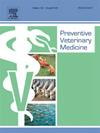Serosurvey of Leishmania infantum in equids in different European countries
IF 2.2
2区 农林科学
Q1 VETERINARY SCIENCES
引用次数: 0
Abstract
Leishmaniosis is a vector-borne and zoonotic disease with major sanitary implications at global scale. In Europe, Leishmania infantum is the only endemic etiologic agent, which has been previously reported in a wide range of mammal. However, the information about the role of equids in the L. infantum epidemiology is limited. We aimed to assess the seroprevalence and identify potential risk factors associated with L. infantum seropositivity in equine populations across several European countries. A total of 1364 equids, including 1005 horses, 240 donkeys and 119 mules/hinnies from Spain, Italy, United Kingdom and Ireland were sampled between 2011 and 2023. The overall seroprevalence of L. infantum was 9.8 % using indirect immunofluorescence test. A significant higher prevalence of anti-L. infantum antibodies was found in donkeys (27.9 %) and mules/hinnies (21.1 %) compared to horses (4.0 %). By country, significantly higher seropositivity was detected in equids from Italy (17.7 %; 70/395) compared to Spain (11.2 %; 63/561), while no positivity was found in animals from Ireland and UK. Our results indicate a moderate and heterogeneous spatial circulation of L. infantum in equids from southern Europe. The variable ‘species’ (donkeys and mules/hinnies) was identified as risk factor associated with L. infantum seropositivity. This survey constitutes the largest seroepidemiological study evaluating the circulation of L. infantum in equids at global scale. Additionally, we report for the first time L. infantum exposure in mules/hinnies in Europe. Our findings suggest the potential role of equids in the L. infantum epidemiological cycle in southern Europe and the need to implement specific surveillance programs in these species.
欧洲不同国家马科动物幼利什曼原虫血清调查
利什曼病是一种媒介传播和人畜共患疾病,在全球范围内具有重大卫生影响。在欧洲,婴儿利什曼原虫是唯一的地方性病原体,以前曾在广泛的哺乳动物中报道过。然而,关于马科动物在婴幼儿乳杆菌流行病学中的作用的信息有限。我们的目的是评估几个欧洲国家马种群中婴儿乳杆菌的血清阳性率,并确定与血清阳性相关的潜在危险因素。2011年至2023年间,共有来自西班牙、意大利、英国和爱尔兰的1364种马科动物,包括1005匹马、240头驴和119头骡子/骡子。间接免疫荧光法检测婴儿乳杆菌血清总阳性率为9.8% %。抗l。与马(4.0% %)相比,在驴(27.9% %)和骡子/母牛(21.1% %)中发现了婴儿抗体。按国家划分,意大利的马科动物血清阳性率明显较高(17.7 %;70/395),而西班牙(11.2 %;63/561),而在爱尔兰和英国的动物中未发现阳性。研究结果表明,欧洲南部马科动物中婴儿乳杆菌的空间循环具有中等程度的异质性。变量“物种”(驴和骡子/母牛)被确定为与婴儿乳杆菌血清阳性相关的危险因素。该调查是全球规模最大的评估婴幼儿乳杆菌在马科动物中传播的血清流行病学研究。此外,我们首次报告了欧洲骡子/骡子中的婴儿乳杆菌暴露。我们的发现提示了马科动物在南欧婴幼儿马科动物流行病学周期中的潜在作用,以及对这些物种实施特定监测计划的必要性。
本文章由计算机程序翻译,如有差异,请以英文原文为准。
求助全文
约1分钟内获得全文
求助全文
来源期刊

Preventive veterinary medicine
农林科学-兽医学
CiteScore
5.60
自引率
7.70%
发文量
184
审稿时长
3 months
期刊介绍:
Preventive Veterinary Medicine is one of the leading international resources for scientific reports on animal health programs and preventive veterinary medicine. The journal follows the guidelines for standardizing and strengthening the reporting of biomedical research which are available from the CONSORT, MOOSE, PRISMA, REFLECT, STARD, and STROBE statements. The journal focuses on:
Epidemiology of health events relevant to domestic and wild animals;
Economic impacts of epidemic and endemic animal and zoonotic diseases;
Latest methods and approaches in veterinary epidemiology;
Disease and infection control or eradication measures;
The "One Health" concept and the relationships between veterinary medicine, human health, animal-production systems, and the environment;
Development of new techniques in surveillance systems and diagnosis;
Evaluation and control of diseases in animal populations.
 求助内容:
求助内容: 应助结果提醒方式:
应助结果提醒方式:


